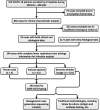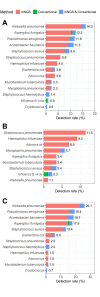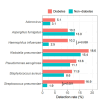Clinical and pathogen features of COVID-19-associated infections during an Omicron strain outbreak in Guangzhou, China
- PMID: 39240085
- PMCID: PMC11448415
- DOI: 10.1128/spectrum.03406-23
Clinical and pathogen features of COVID-19-associated infections during an Omicron strain outbreak in Guangzhou, China
Abstract
Although the Omicron variant has been associated with greater transmissibility and tropism of the upper respiratory tract, the clinical and pathogenic features of patients infected with the Omicron variant during an outbreak in China have been unclear. Adults with COVID-19 were retrospectively enrolled from seven medical centers in Guangzhou, China, and clinical information and specimens ( BALF, sputum, and throat swabs) from participants were collected. Conventional detection methods, metagenomics next-generation sequencing (mNGS), and other methods were used to detect pathogens in lower respiratory tract samples. From December 2022 to January 2023, we enrolled 836 patients with COVID-19, among which 56.7% patients had severe/critical illness. About 91.4% of patients were infected with the Omicron strain (BA.5.2). The detection rate of possible co-infection pathogens was 53.4% by mNGS, including Klebsiella pneumoniae (16.3%), Aspergillus fumigatus (12.2%), and Pseudomonas aeruginosa (11.8%). The co-infection rate was 19.5%, with common pathogens being Streptococcus pneumoniae (11.5%), Haemophilus influenzae (9.2%), and Adenovirus (6.9%). The superinfection rate was 75.4%, with common pathogens such as Klebsiella pneumoniae (26.1%) and Pseudomonas aeruginosa (19.4%). Klebsiella pneumoniae (27.1%% vs 6.1%, P < 0.001), Aspergillus fumigatus (19.6% vs 5.3%, P = 0.001), Acinetobacter baumannii (18.7% vs 4.4%, P = 0.001), Pseudomonas aeruginosa (16.8% vs 7.0%, P = 0.024), Staphylococcus aureus (14.0% vs 5.3%, P = 0.027), and Streptococcus pneumoniae (0.9% vs 10.5%, P = 0.002) were more common in severe cases. Co-infection and superinfection of bacteria and fungi are common in patients with severe pneumonia associated with Omicron variant infection. Sequencing methods may aid in the diagnosis and differential diagnosis of pathogens.
Importance: Our study has analyzed the clinical characteristics and pathogen spectrum of the lower respiratory tract associated with co-infection or superinfection in Guangzhou during the outbreak of the Omicron strain, particularly after the relaxation of the epidemic prevention and control strategy in China. This study will likely prompt further research into the specific issue, which will benefit clinical practice.
Keywords: Aspergillus; COVID-19; Klebsiella pneumoniae; Omicron strain; co-infection; diabetes mellitus; superinfection.
Conflict of interest statement
The authors declare no conflict of interest.
Figures




References
-
- Lu L, Mok BWY, Chen LL, Chan JMC, Tsang OTY, Lam BHS, Chuang VWM, Chu AWH, Chan WM, Ip JD, Chan BPC, Zhang R, Yip CCY, Cheng VCC, Chan KH, Jin DY, Hung IFN, Yuen KY, Chen H, To KKW. 2022. Neutralization of severe acute respiratory syndrome coronavirus 2 Omicron variant by sera from BNT162b2 or CoronaVac vaccine recipients. Clin Infect Dis 75:e822–e826. doi:10.1093/cid/ciab1041 - DOI - PMC - PubMed
-
- Tseng HF, Ackerson BK, Luo Y, Sy LS, Talarico CA, Tian Y, Bruxvoort KJ, Tubert JE, Florea A, Ku JH, Lee GS, Choi SK, Takhar HS, Aragones M, Qian L. 2022. Effectiveness of mRNA-1273 against SARS-CoV-2 Omicron and delta variants. Nat Med 28:1063–1071. doi:10.1038/s41591-022-01753-y - DOI - PMC - PubMed
MeSH terms
Supplementary concepts
Grants and funding
LinkOut - more resources
Full Text Sources
Medical

